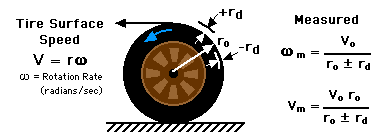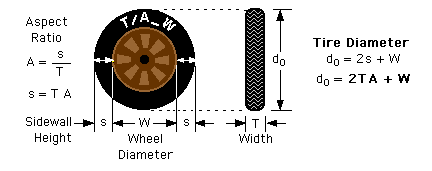
|
Vm = Vo [ ro / (ro ± rd) ]
Verr = 100 { [ ro / (ro ± rd) ] -1 } % |
Pacing with the speedometer involves the patrol car following a vehicle while maintaining a constant range separation. This method depends on the ability of the officer to maintain patrol car speed with target speed and the accuracy of the patrol car speedometer. Some agencies recommend a target vehicle should be paced for at least 0.2 miles, and only forward vehicles, not vehicles in the rear view mirror.
| Speedometers |
There are 2 basic types of speedometers, mechanical and electronic. The oldest type of speedometer is mechanical and still used. Electronic speedometers, also called Vehicle Speed Sensors (VSS), started showing up in the 1980's and are common on most new vehicles.
MECHANICAL -- Mechanical speedometer's use a flexible rotating cable usually connected by gears or sometimes magnets to the transmission case vehicle drive shaft or differential assembly. Many motorcycles and early Volkswagen Beetles connect to a front wheel.
ELECTRONIC -- Vehicle Speed Sensors use electrical signals from sensors, usually magnetic but sometimes gears, mounted to the transmission case vehicle drive shaft or differential assembly. Some VSS's use wheel sensor data to calculate speed, some use Anti-lock Brake System (ABS) data. Some police radar's use VSS data to detect patrol speed shadowing in moving mode operation.
All speedometers should be calibrated on a periodic basis, and repaired if out of factory specifications. Specified accuracy varies with make and model and can easily be ± 2 mph or more. There should be a calibration paperwork trail that includes at the very least;
|
Speedometer Accuracy
Tire pressure and diameter varies with use and conditions. As long as the tires are maintained with proper cold tire pressure and used within specifications, not exceeding maximum load and speed, speedometer accuracy will be within factory specifications. The greater the actual diameter is different from the standard speedometer calibrated diameter, the greater the measured speed error.

|
Vm = Vo [ ro / (ro ± rd) ]
Verr = 100 { [ ro / (ro ± rd) ] -1 } % |
Vm = measured speed (speedometer)
Vo = actual speed
Verr = speed error in percent (%)
ro = tire radius when speedometer calibrated
rd = tire radius difference (-rd for smaller radius, +rd for larger)
Vm in same units as Vo (mph, km/hr, etc.), ro and rd must be in same units (inches, feet, millimeters, meters, etc.).
|
Vm = Vo ( do / d1 )
Verr = 100 [ (do / d1) -1 ] % |
do = tire diameter when speedometer calibrated
d1 = different tire (diameter)
Vm in same units as Vo (mph, km/hr, etc.), do and d1 must be in same units (inches, feet, millimeters, meters, etc.).
| Tire Specifications |
Many tires have sidewall markings that list tire width, aspect ratio or sidewall height to width, and wheel diameter. Tire diameter can be derived from width, aspect ratio, and wheel diameter.

The International Organization for Standardization (ISO) uses a T/A_W, format usually embedded in the tire code.

| T | 3 digit number | Nominal Width at widest point in millimeters (mm) |
|---|---|---|
| A | 2 or 3 digit number | Aspect ratio (sidewall height / width) as a percent (if omitted = 82%, if > 200 diameter in mm). |
| W | 2 digit number | Wheel Diameter in Inches. |
|
do in inches = (TA / 1270) + W
do in mm = (0.02 TA) + (25.4 W) |
| ||||||||
TIRE FACTORS
All speedometers depend on the tires maintaining a constant diameter. If the actual tire diameter is smaller than the standard tire diameter, speed measures HIGH. If actual diameter is greater than standard, speed measures low. The greater the difference the greater the speed error.
|